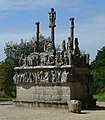Notre-Dame de Tronoën
Notre-Dame de Tronoën is a small Gothic chapel with the oldest Calvaire in Brittany . It has been classified as a Monument historique since 1907 .
The chapel and the calvary belong to the parish of Saint-Jean-Trolimon.
Until the French Revolution this community was a Trève , i. H. a subdistrict, the parish of Beuzec Cap Caval. The name Tronoën comes from Breton and derives from Tro-an-aon , d. H. “Part of the community lying at a source”, from.
Notre-Dame de Tronoën chapel
It is lonely in a wide dune and heathland between the Pointe de la Torche and Saint-Jean-Trolimon , nine kilometers west of Pont-l'Abbé .
The origin of the chapel and calvary is dated between 1450 and 1470.
The interior of the chapel consists of a very wide nave and a side aisle.
Noteworthy are:
- the Gothic stone vault
- a magnificent central pillar for the substructure of the church tower
- a large altar measuring 5.35 m in length
The current windows of the chapel date from 1990. Their design reminds us that the chapel is dedicated to Notre Dame des Douleurs (“Mary of Sorrows”). In addition, their colors take up the blue sea and the yellow dunes.
Every year on the third Sunday in September, the Pardon de Notre Dame de Tronoën pilgrimage festival is celebrated in the chapel. Since 2012 it has been dedicated to intercession for water sports enthusiasts (surfers, bodyboarders, etc.).
A male figure is hidden in the Romanesque portal, who seems to be looking out of a crack - the scout .
Calvary
The Kalvarienberg consists of a cuboid structure with a length of 4.50 meters and a width of 3.50 meters, which is clad on the south side with granite from Scaër and on the north side with granite from Kersanton. The south side is more weathered and covered with lichen.
The three crosses of Golgotha stand on the base, on the back of which there are individual statues:
- Veronica's handkerchief
- Pietà
- a standing James as a pilgrim in a long robe with a staff and hat
Two friezes depicting events from the New Testament surround the base.
Due to the weathering, individual scenes can hardly be recognized and are interpreted differently.
The upper frieze shows among other things
- Jesus as a gardener in the Mount of Olives,
- the flagellation of Christ
- the Lord's Supper
The lower frieze with smaller figures, which is attributed to another artist, shows
- Birth scene with Mary with a bare breast with a Jesus as the King of the World and not as an infant
- The three kings
- Annunciation of Mary
- Christ carrying the cross
Web links
- Entry no.PA00090420 in the Base Mérimée of the French Ministry of Culture (French)
Individual evidence
- ^ Frank and Almut Rother: The Bretagne. DuMont art travel guide, Cologne 1985, pp. 145f.
- ^ The green travel guide Bretagne, Michelin Reiseverlag, Landau 2000, p. 138.
Coordinates: 47 ° 51 ′ 22.4 " N , 4 ° 19 ′ 42" W.







